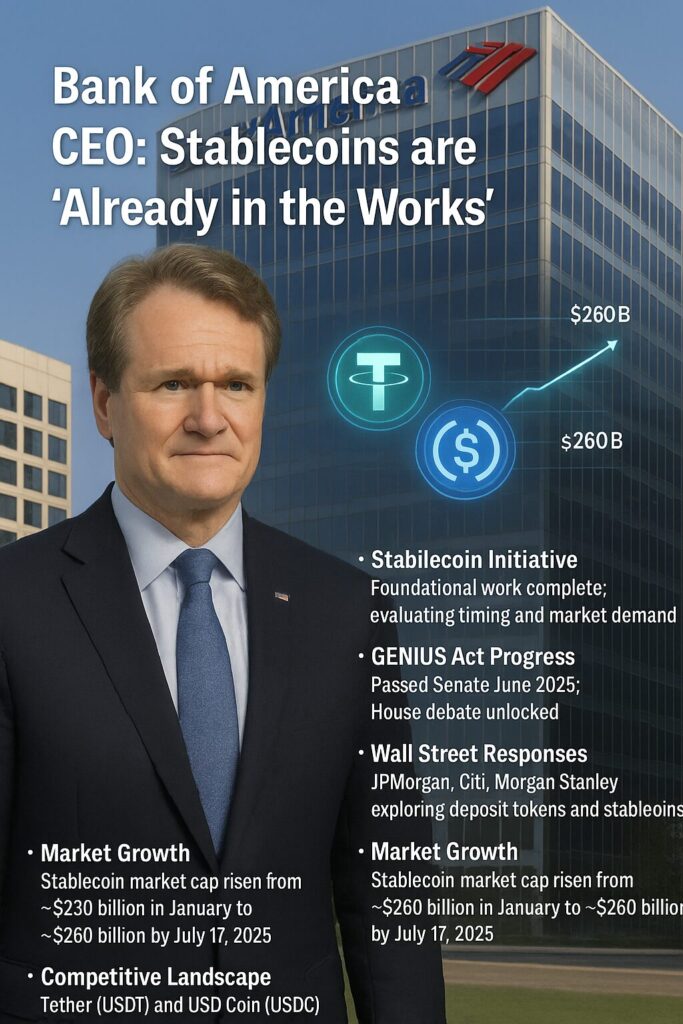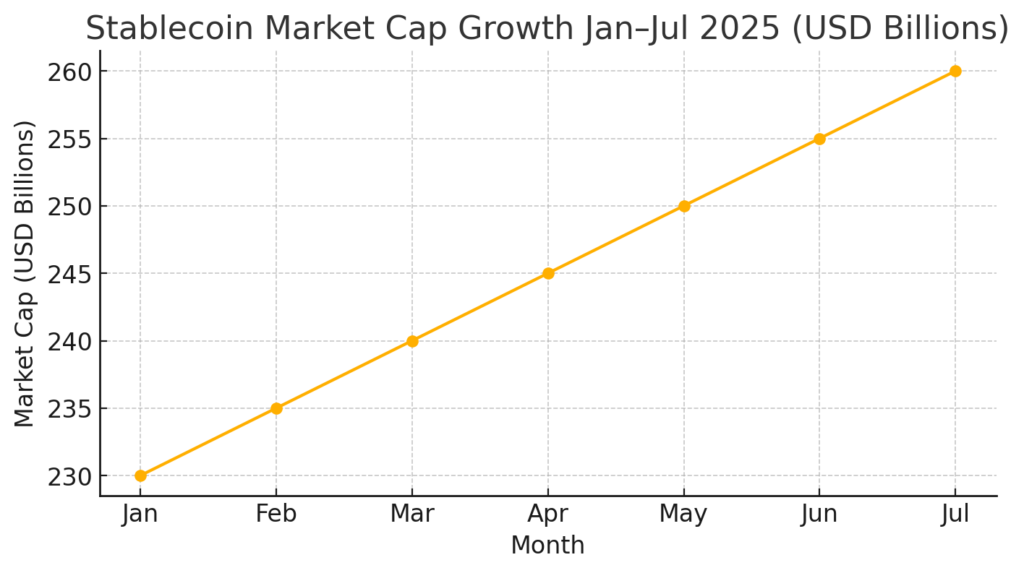
Main Points:
- Bank of America’s Stablecoin Initiative: BoA has completed foundational work and is evaluating timing and market demand.
- GENIUS Act Progress: Senate passed in June 2025; House debate recently unlocked after deal-making.
- Wall Street Responses: JPMorgan, Citi, and Morgan Stanley are all actively exploring or planning deposit tokens and stablecoins.
- Market Growth: Stablecoin market cap has risen from ~$230 billion in January to ~$260 billion by July 17, 2025.
- Competitive Landscape: Tether (USDT) and USD Coin (USDC) together hold over 75% of the market.
Stablecoin Market Growth Chart
Above is a clear illustration of the continuous expansion in stablecoin adoption, as total market capitalization climbed steadily from $230 billion in January to $260 billion by mid-July 2025. This growth underscores growing institutional and retail interest in stablecoins as a bridge between fiat and digital currencies.

Bank of America’s Foray into Stablecoins
Bank of America CEO Brian Moynihan confirmed on July 16, 2025, during the Q2 earnings call that the bank “has already undertaken substantial foundational work” on launching its own stablecoin. While BoA has not set a fixed launch date, Moynihan emphasized that the institution is “still gauging the size of the opportunity and client demand” before formally introducing the product. He noted that some regions exhibit lower transaction volumes, indicating that BoA will proceed “when the time is right” and likely in partnership with other firms to share expertise and distribution channels.
The GENIUS Act: A Dual-Layer Regulatory Framework
On June 17, 2025, the U.S. Senate passed the Guiding and Establishing National Innovation for U.S. Stablecoins Act (GENIUS Act) by a bipartisan vote of 68–30, marking the first major stablecoin legislation to clear either chamber. However, its advancement stalled in the House due to disputes over anti-CBDC provisions. A breakthrough vote on July 17, 2025, revived debate after House GOP leaders agreed to attach the Anti-CBDC Surveillance State Act to the National Defense Authorization Act, passing procedural hurdles by a 217–212 margin. If enacted, the GENIUS Act will impose reserve, audit, and transparency requirements on “permitted payment stablecoin issuers,” fostering legal certainty that many banks demand before committing to large-scale deployments.
Wall Street’s Stablecoin Strategies
JPMorgan Chase: From Skepticism to Participation
Jamie Dimon, CEO of JPMorgan Chase, acknowledged on July 15, 2025, that despite personal doubts about bitcoin’s long-term utility, JPMorgan will “be involved in both JPMorgan DepositCoin and stablecoins to understand them and to be good at them”. JPMorgan is exploring a joint stablecoin with major players like Citi and Wells Fargo, aiming to leverage network effects and shared infrastructure.
Citigroup: Projecting Trillions in Market Potential
Citigroup CEO Jane Fraser also confirmed on July 16, 2025, that Citi is investigating its own stablecoin to enhance digital payment capabilities. Citi Institute’s projection anticipates stablecoin supply could reach $1.6 trillion in a base case and up to $3.7 trillion by 2030 under bullish adoption scenarios. Despite the Senate’s passage of the GENIUS Act, a fresh gridlock in the House has momentarily paused progress.
Morgan Stanley and Others
Morgan Stanley’s CFO has indicated that the firm is assessing stablecoins’ applicability for treasury and settlement functions, though it remains early in their evaluation process. Other financial giants, including Wells Fargo and Bank of New York Mellon, are quietly piloting tokenized deposit initiatives, signaling that stablecoins may soon move from concept to operational reality across the banking sector.
Market Dynamics and Competitive Landscape
The stablecoin market continues to consolidate around a few major players. As of July 17, 2025, DefiLlama reports total market cap at $259.7 billion, with Tether’s USDT dominating 62.4% (~$162 billion) and Circle’s USDC holding roughly 22.7% (~$59 billion). Together, USDT and USDC comprise over 85% of the stablecoin ecosystem, followed distantly by BUSD, DAI, and other algorithmic variants. This duopoly reflects institutional trust in reserve-backed tokens but also leaves room for regulated bank-issued stablecoins to capture niche segments, such as corporate treasury management and cross-border remittances.
Conclusion
As regulatory clarity approaches with the potential enactment of the GENIUS Act, the stablecoin market stands on the cusp of a new institutional era. Major banks—including Bank of America, JPMorgan Chase, and Citigroup—are aligning strategic initiatives to issue their own tokens, betting on stablecoins as critical infrastructure for next-generation payments. Meanwhile, the market’s rapid growth from $230 billion to $260 billion in mid-2025 highlights robust demand. Although Tether and USDC currently dominate, bank-backed stablecoins are poised to leverage regulatory frameworks and existing client networks, driving further innovation and adoption across both traditional finance and decentralized ecosystems.

